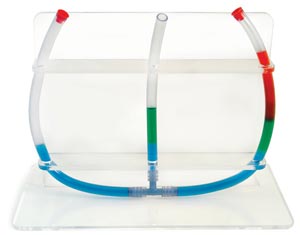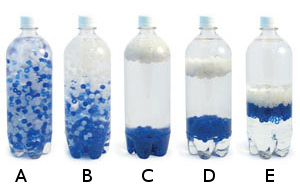 by: Tami O’Connor
by: Tami O’Connor
Why do some objects float while others sink? Archimedes discovered that an object is buoyed upward with a force equal to the weight of the fluid displaced. An object will float in a fluid whenever its weight is less than the weight of the fluid displaced; otherwise it will sink… So what does this mean in English??? An easier way to think about it is that an object that is less dense than the fluid it is in will rise to the top of the more dense fluid.
 In demonstrations of liquids of varying densities, the liquid with the greatest density will sink to the bottom of the container while the less dense liquid will remain on the top. There are wonderful demonstrations you can conduct with your class using immiscible liquids (liquids that do not mix) of different densities, and there are a number of high interest experiments your students can conduct using liquids of different densities. If you find this topic interesting, please visit the blog we wrote on the W-Tube.
In demonstrations of liquids of varying densities, the liquid with the greatest density will sink to the bottom of the container while the less dense liquid will remain on the top. There are wonderful demonstrations you can conduct with your class using immiscible liquids (liquids that do not mix) of different densities, and there are a number of high interest experiments your students can conduct using liquids of different densities. If you find this topic interesting, please visit the blog we wrote on the W-Tube.
Gasses also have varying densities, but in the elementary and middle school classrooms, students don’t often have the same opportunity to work with gasses as they would liquids, or more often, liquids and solids.
Density of Gasses Activity
I had an activity showing the varying density of gasses that was always a big hit in my classroom or during science assemblies that clearly demonstrated that helium is less dense than air. It involved a small helium tank, a filled helium balloon (I always used Mylar to eliminate any issues with latex allergies), and a clear kitchen garbage bag. I would bring out the helium balloon and ask my students why it floated. It is usually easier for younger students to comprehend density when you relate floating and sinking to objects they recognize like balloons or boats…
Most students answered that the helium is lighter (or less dense) than the air, and therefore, the balloon floats. The next thing I did was to inflate the clear kitchen garbage bag with helium. After it was about 3/4 full of helium and floating with the closed end facing upward, I would show that the bottom of the bag can be open yet no helium escapes. I often received some perplexed looks from my students until I explained that the less dense gas that was inside the bag was trying to get out of the top (sealed end) of the bag, rather than the bottom.
Then, while holding the bottom of my floating kitchen garbage bag, I would ask the students to estimate how much helium vs. air was in the bag. Since both gasses are clear, and the helium inside the bag made it float, this was not an easy question to answer. I would then ask my students to come up with a plan to determine where the line between the helium and the air was. There were always interesting ideas, but the easiest one I found was to simply use the helium-filled Mylar balloon to determine where the air ended and the helium began.
By releasing the Mylar balloon into the open end of the clear garbage bag, the balloon floated up until it hit the helium and remained floating (about 3/4 of the way up the bag). Even the younger students were able to explain that the helium balloon was lighter than air so it floated above the air. It didn’t float above the helium, however, since even though the balloon contained helium, the Mylar added weight keeping the balloon at the bottom of the helium layer.
Solar Tube Activity
The next lesson compared hot air to cooler air. For this activity I needed a sunny but cool day, a Solar Tube complete with string, and… a lot of room. By a lot of room, I mean a large field devoid of trees… The best bag to use is found at Educational Innovations, because at 60 feet, it is the longest and creates the most impressive demonstrations!
The bag I am talking about is made from a very thin, black plastic. I would tend to conduct this activity early in the day when the air was cool. By unraveling the tube, holding open the end of it and jogging, so the air entered the opening, we were able to inflate the bag easily. When the bag was filled with air, we tied the open end, attached the string and held the Solar Tube so it was fully exposed to the sunlight.
As we know, dark objects absorb heat. In a short time, the Solar Tube became warm to the touch, and my students were clearly able to see the tube expanding because the plastic on the tube became taut. Within about 5 minutes the Solar Tube floated high into the sky! Because the air inside the tube became hotter, the molecules moved apart, taking up less space. When there are fewer molecules in a given space, the substance becomes less dense than objects around it that have more molecules in the same volume. Few things are more impressive to an elementary or middle school child than to see a 60 foot long hot dog shaped balloon rise high into the sky, tethered only by a kite string…

